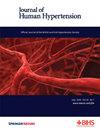顽固性高血压的脑血管反应性损害。
IF 3.4
4区 医学
Q2 PERIPHERAL VASCULAR DISEASE
引用次数: 0
摘要
顽固性高血压(RH)是指在同时使用三种或三种以上降压药的情况下,收缩压(BP)仍然不受控制,并可能与生理刺激下血管舒张反应的改变有关。然而,RH对脑血管反应性(CVR)的影响仍然知之甚少。此外,自主神经系统功能障碍对这些改变的潜在贡献尚未完全阐明。了解这些机制可能有助于了解顽固性高血压的病理生理学,并可能具有重要的预后意义。本研究旨在分析RH患者与非顽固性高血压(NRH)患者队列中的CVR,并考虑两组交感迷走神经平衡的差异。连续40例高血压患者,20例NRH和20例RH,在静息和屏气操作期间进行心率变异性分析和经颅彩色编码多普勒测量以评估CVR。与对照组相比,高血压患者屏气指数(BHI)和时域参数(SDNN和SDANN)显著降低(BHI对照组1.32±0.41 vs高血压组0.92±0.65;p = 0.018;SDANN对照组125.76±24.96 vs高血压组87.65±20.63;p本文章由计算机程序翻译,如有差异,请以英文原文为准。

Cerebrovascular reactivity impairment in resistant hypertension
Resistant hypertension (RH) is defined as office systolic blood pressure (BP) that remains uncontrolled despite the concurrent use of three or more antihypertensive drug classes and may be associated with altered vasomotor responses to physiological stimuli. However, the effect of RH on cerebrovascular reactivity (CVR) remains poorly understood. Furthermore, the potential contribution of autonomic nervous system dysfunction to these alterations has not yet been fully clarified. Understanding these mechanisms may offer insights into the pathophysiology of resistant hypertension and could have important prognostic implications. This study aims to analyze CVR in a cohort of patients with RH, compared with patients with non-resistant hypertension (NRH), taking into account the differences in sympathovagal balance between the two groups. Forty consecutive hypertension patients, 20 with NRH and 20 with RH, underwent heart rate variability analysis and transcranial color-coded Doppler at rest and during a breath-holding maneuver to evaluate CVR. Hypertensive individuals presented a significant reduction of the Breath Holding Index (BHI) and time-domain parameters (SDNN and SDANN) in comparison to the control group (BHI control 1.32 ± 0.41 vs hypertensive 0.92 ± 0.65; p = 0.018; SDANN control 125.76 ± 24.96 vs hypertensive 87.65 ± 20.63; p < 0.0001). RH patients presented a significant reduction in BHI (NRH BHI 1.15 ± 0.65 vs RH BHI 0.70 ± 0.58; p = 0.027) and HRV parameters (SDANN in NRH 95.09 ± 22.12 vs RH 80.21 ± 16.36; p = 0.021). Our results show that RH is associated with impaired HRV and CRV. Autonomic dysfunction could be a concurrent cause of cerebral vasomotor reactivity impairment.
求助全文
通过发布文献求助,成功后即可免费获取论文全文。
去求助
来源期刊

Journal of Human Hypertension
医学-外周血管病
CiteScore
5.20
自引率
3.70%
发文量
126
审稿时长
6-12 weeks
期刊介绍:
Journal of Human Hypertension is published monthly and is of interest to health care professionals who deal with hypertension (specialists, internists, primary care physicians) and public health workers. We believe that our patients benefit from robust scientific data that are based on well conducted clinical trials. We also believe that basic sciences are the foundations on which we build our knowledge of clinical conditions and their management. Towards this end, although we are primarily a clinical based journal, we also welcome suitable basic sciences studies that promote our understanding of human hypertension.
The journal aims to perform the dual role of increasing knowledge in the field of high blood pressure as well as improving the standard of care of patients. The editors will consider for publication all suitable papers dealing directly or indirectly with clinical aspects of hypertension, including but not limited to epidemiology, pathophysiology, therapeutics and basic sciences involving human subjects or tissues. We also consider papers from all specialties such as ophthalmology, cardiology, nephrology, obstetrics and stroke medicine that deal with the various aspects of hypertension and its complications.
 求助内容:
求助内容: 应助结果提醒方式:
应助结果提醒方式:


